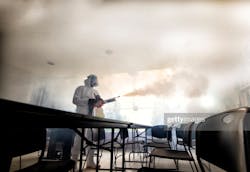The fire service must continue to comprise flexible organizations that adapt and adjust as more information about the profession emerges and society changes. Because of COVID-19, fire departments have taken a different approach to decontamination and sanitation and have renewed their commitment to universal precautions.
Of course, one may argue that the trend for more emphasis on decontamination was the result of more research that showed the increase of the likelihood of firefighters contracting cancer. Regardless, the bottom line is that there is adequate information to demonstrate the importance of these functions. To improve, organizations are turning to their health and safety officer (HSO) for information, recommendations and counsel regarding approaches and options. This requires HSO involvement in station usage—and it also should include assistance in station design.
The situation also requires action that’s driven by the medical profession, which considers itself a practice, and science, which never is final. Departments must stay current on guidelines that are issued by the Centers for Disease Control and Prevention (CDC) and on direction from local health directors and their medical control directors. That said, as guidelines are released, they must be interpreted. Don’t discount that there are elements of politics to be considered—locally, on a state level and nationally.
The good news for most departments, particularly those that provide EMS service, is that they have been committed to infection-control programs for a long time. One may even argue that firefighters pay more attention to safety considerations in conjunction with their EMS responsibilities than they do on the fireground. The use of universal precautions has become somewhat second nature.
In the case of COVID-19, additional steps must be taken. Although the circumstances that are presented on the emergency call dictate the level of protection, the infection rate of this virus requires an approach by which all incidents must be considered a potential threat of transmission. To move this a step further, the precautions must be taken all the way back to the fire station. This is necessary so that the hazard isn’t brought to the fire station and maximum protections are afforded to the responders and others who weren’t on scene.
Beyond the obvious
Prior to when the COVID-19 pandemic struck, the fire service was improving operations with respect to decontamination and sanitation. However, the factors that are related to the pandemic necessitated a re-evaluation of operational issues.
Nevertheless, there still are things that can be learned from history and past practices. These can come from one’s own department, other departments or agencies that have similar challenges. Some of the elements that are learned would lead one to conclude that most, if not all, existing fire stations have challenges that make some of the necessary actions difficult to put into place: The older the station, the less space and fewer options that are available to implement necessary policies and procedures. When designing fire stations, there must be foresight that there will be future needs that don’t exist today. No one who constructed a fire station in 2015 put in precautions to address a pandemic, but you could poll anyone who was part of developing a fire station 5 or 10 years ago about what they would do differently, and you probably would get some responses.
Members of a department who respond as part of a hazmat team probably set the standard regarding decontamination and the establishment of Hot, Warm and Cold Zones. This has been extended to the fireground and, essentially, all emergencies. More recently, the concept has become a part of fire stations. Some variations are needed for a virus that’s spread through the air regarding an evaluation of the Hot, Warm, and Cold Zones in stations. Again, depending on the age of the fire station, there might be some limitations on how this concept is implemented. However, for those who are looking at new fire stations, decontamination and Hot/Warm/Cold Zones must become part of the discussion very early in the conceptualization of the station. Unfortunately, this won’t be universally accepted, because there is an associated cost. Therefore, HSOs must become well-versed in the reasoning and justification. The good news is that there are many fine examples and plenty of information available.
Multiple ‘workspaces’
Producing a safe working environment depends on keeping known hazards out of areas that are unprotected and where PPE isn’t utilized and regular living occurs. This applies to the isolation of carcinogens and novel viruses alike. Elements that must be considered include showers, gross decontamination methods and built-in features, such as negative pressure rooms that help to isolate hazards. Managing the process is important. You must know what contaminations are entering the station and the best way to protect firefighters while eliminating the hazards. Simple action, such as gross decontamination, followed by showers to remove toxins from firefighters, might be all that’s needed. In cases where the contaminants must be disposed of properly, systems must be established: Not everything should be flushed down the sewer.
Because stations function as living spaces, they are set up to accommodate those who live there, but some of the changes that are needed consider social distancing, the wearing of masks, locating decontamination stations in various parts of the station and regularly wiping down surfaces. Departments might have sprayers, more disinfectant products and larger supplies of PPE, including gloves, masks, eyewear and gowns. This requires finding storage space, which isn’t always an easy task in cramped fire stations. So, again, those who are looking to construct new stations must anticipate that the future will require more space from some emerging or unknown change in operations.
The HSO must be a vital cog in the development and updating of department policies and procedures. This is more challenging with invisible viruses that can be transmitted unknowingly. Besides the usual decontamination procedures, the organization needs policies that perform symptom checks that include temperature checks and sign-in sheets. In some states, these policies might be a requirement of the Occupational Safety and Health Administration. Depending on the layout of a station, its size and the location of entry/exit points, acceptable patterns for people to enter and exit might need to be established.
Right people, right messages
Firefighters generally are logical, but they also can have a cynical side. Many will look at an issue or a challenge and compare it with the suggested solution. If it makes sense, they will comply. If it is against their common sense, they will question the actions. Of course, the department, shift, station culture and peer pressure factor into this.
Department actions, including policies and procedures, must make sense and comply with sound recommended practices. As the science evolves, so must the organization. Departments that don’t pay attention soon will find that members will take their own steps for their protection. This might or might not align with the wishes of the department. The best way to ensure that department actions make sense and comply with sound practices is to have the right people in charge and to make sure that the right messages are delivered. There is no doubt that the fire service is getting more complex across the board and that new responsibilities are added seemingly every day. The pandemic adds to the complexity. Departments must utilize their resources, including the HSO, who has an interest in the well-being of the personnel and will commit the energy that’s needed to complete every assignment. An HSO’s work has become vital in protecting what everyone agrees is the most valuable resource: their people.
As new threats continue to be added to the old ones, someone must stay on top of the emerging issues. Certainly, creating as safe a workspace as possible for firefighters falls into that realm. When they leave the comfort of the station to go take care of a problem, they must know that when they return to their home away from home they are offered the best protection possible.
Richard Marinucci will moderate the "Health Safety Officer" pre-conference workshop at Firehouse Expo. To register, visit firehouseexpo.com.
About the Author

